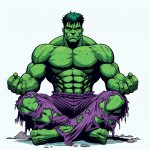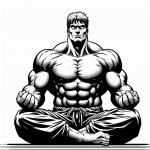overgeeked
Open-World Sandbox
But this one...

You'd have to ask the artist for original digital files showing they worked on the image. Even then, it's fairly easy to fake a lot of that.
Take that image, drop the CMY channels, go in and remove the shading, and you're left with the line art. Touch that up, then drop the shading and color into separate layers. There'd basically be no way to tell. Unless you force people to work with pen and ink and physically ship their originals and sketches to you.
You can also have the "AI" provide black and white line art from the jump. Shading and coloring that would be dead simple.
From there, how do you prove the person created the original line art?
Like this.

It would take someone who knew what they were doing maybe 15-20 minutes to do a basic shading and coloring of that.
(Except for the wrong number of fingers on the left hand, but that's not the point I was illustrating.)

You'd have to ask the artist for original digital files showing they worked on the image. Even then, it's fairly easy to fake a lot of that.
Take that image, drop the CMY channels, go in and remove the shading, and you're left with the line art. Touch that up, then drop the shading and color into separate layers. There'd basically be no way to tell. Unless you force people to work with pen and ink and physically ship their originals and sketches to you.
You can also have the "AI" provide black and white line art from the jump. Shading and coloring that would be dead simple.
From there, how do you prove the person created the original line art?
Like this.

It would take someone who knew what they were doing maybe 15-20 minutes to do a basic shading and coloring of that.
(Except for the wrong number of fingers on the left hand, but that's not the point I was illustrating.)
Last edited:


